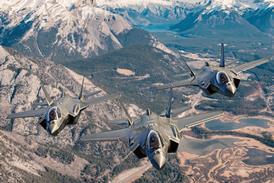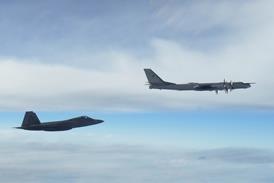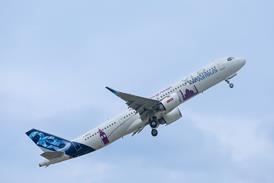
GE Aerospace
GE Aerospace, an operating unit of GE (NYSE: GE), is a world-leading provider of jet engines, components, and systems for commercial and military aircraft with a global service network to support these offerings. GE Aerospace and its joint ventures have an installed base of more than 44,000 commercial and 26,000 military aircraft engines, and the business is playing a vital role in shaping the future of flight.
Contact info
- Website:
- www.GEAerospace.com
 Paid content
Paid contentGE Aerospace joins new 100% SAF consortium
A new aviation industry coalition is bringing together leading aerospace companies. International Aerospace Environmental Group (IAEG) recently formed a work group to study the impact of 100% Sustainable Aviation Fuel (SAF) on airplane and engine systems and evaluate technical issues. Learn more here.
 Paid content
Paid contentGE Aerospace advances hybrid electric engine development
GE Aerospace is developing a hybrid electric demonstrator engine with NASA that will embed electric motor/generators in a high-bypass commercial turbofan to supplement power during different phases of operation. It’s one of several efforts GE Aerospace has underway to mature technologies for more electric aircraft engines. Learn more here
 Paid content
Paid contentCFM International’s RISE Program Gains Momentum
As technology testing continues for the RISE program, momentum is growing. Unveiled in 2021 by CFM International, a 50/50 joint company between GE Aerospace and Safran Aircraft Engines, the program is advancing flight technologies that aim to be 20% more fuel efficient than current commercial engines.
 Paid content
Paid contentWhen revolutionary technologies meet passionate GE Aerospace engineers
What started as a fun family activity for GE Aerospace engineer Michał Janczak became a passion project that put his engineering skills to the test. Using 19,000 LEGO bricks, he worked to build a replica of the pioneering RISE program’s open fan engine architecture being developed by CFM International.
 Paid content
Paid contentGE Aerospace remains focused on sustainability
GE Aerospace is at the forefront of the aviation industry’s quest for net zero emissions. At the Singapore Airshow, they showcased the Revolutionary Innovation for Sustainable Engines (RISE) program, aimed at reducing fuel consumption and CO2 emissions by over 20% compared to today’s most efficient engines. The RISE program features ...
 Paid content
Paid contentGE Aerospace pioneers advancements in MRO
GE Aerospace has a long legacy in engine technology, manufacturing renowned products like the Boeing 787’s GEnx, GE9X on the soon-to-be-certificated 777X, and CFM LEAP engines in collaboration with Safran. Beyond engine design, the company is pioneering advancements in Maintenance, Repair, and Overhaul (MRO) operations. Its Singapore facility is the ...
 Paid content
Paid contentGE Aerospace highlights commitment to Asia-Pacific
The vast Asia-Pacific region is one of the most dynamic for global aerospace, with a growing appetite for air travel fuelling demand for the industry’s latest products and technologies. GE Aerospace is a business that has been helping people fly for almost as long as aviation has been around, and ...
 Paid content
Paid contentGE Aerospace achieves new 100% SAF milestone
Ten different engine models made by GE Aerospace and its joint ventures have been tested with 100% Sustainable Aviation Fuel (SAF) since 2016 through a mix of component-, engine-, and aircraft-level tests.
 Paid content
Paid contentBehind the GE9X engine’s advanced technologies
The world’s largest and most powerful certified commercial aircraft engine, the GE9X is also GE Aerospace’s most efficient engine built per pounds of thrust. Incorporating advanced technologies, the GE9X engine is designed to deliver up to 10% greater fuel efficiency than its predecessor, with emissions of nitrogen oxides (NOx) 55% ...
 Paid content
Paid contentGE Aerospace joins effort testing SAF impact on contrails
Sustainable Aviation Fuel can reduce carbon emissions by up to 85% over the fuel’s life cycle and produce less soot than conventional jet fuel. Boeing’s latest ecoDemonstrator Explorer is conducting flight tests, in collaboration with GE Aerospace, NASA, and United Airlines, that aim to determine how SAF can impact contrails.
 Paid content
Paid contentGE Aerospace debuts look of hybrid electric aircraft
GE Aerospace recently joined NASA and Boeing to unveil the paint scheme of its hybrid electric aircraft testbed for the Electrified Powertrain Flight Demonstration (EPFD) project. In coming years, the plane will take to the skies to test new hybrid electric propulsion systems in development for the future of commercial aviation.
 Paid content
Paid contentHow the CFM RISE programme arose
Two years after unveiling one of the aviation industry’s most comprehensive technology demonstrator programmes for a more sustainable future of flight, CFM International has completed more than 100 tests as part of its Revolutionary Innovation for Sustainable Engines (RISE) programme. Learn more about the history of innovation leading to RISE.
 Paid content
Paid contentGE Aerospace investment supports hybrid electric engine development
GE Aerospace plans to invest up to $20 million to add a new test cell and equipment at its Electrical Power Integrated Systems Center (EPISCenter) in Ohio, U.S., to meet increased demand for hybrid electric aircraft engine component testing in coming years.
 Paid content
Paid contentGE Aerospace experts help explain the state of SAF
In this Q&A with two of GE Aerospace’s Sustainable Aviation Fuel (SAF) experts, learn more about how the engine maker is helping advance the adoption of the alternative fuel in the industry, as well as the importance of 100% SAF testing and increasing SAF production.
 Paid content
Paid contentGE Aerospace’s history of 100% SAF testing
All GE Aerospace engines can operate on approved Sustainable Aviation Fuel (SAF) blends today. GE Aerospace also supports industry initiatives to qualify and adopt 100% SAF through its own testing and through industry collaborations.
 Paid content
Paid contentGE Aerospace supports another first for 100% SAF
In another milestone for 100% SAF development, Emirates has operated the first demonstration flight in the Middle East using the still experimental jet fuel in one of two GE90 engines powering a Boeing 777. The flight supports efforts to reduce lifecycle CO2 emissions as Emirates and GE Aerospace explain here.
 Paid content
Paid contentGE Aerospace, Boeing, NASA collaborate to advance flight
Achieving the aviation industry’s goal of net zero carbon emissions by 2050 is an ambitious, challenging target. Sustainable Aviation Fuel (SAF) and hybrid electric propulsion are two major areas GE Aerospace is committed to driving forward as it collaborates with other key players in the industry.
 Paid content
Paid contentGE Aerospace’s advanced materials for improved engine efficiency
As one of the world’s largest suppliers of aircraft engines, systems and services, GE Aerospace continues to be an industry leader in developing technologies to reduce CO2 emissions from flight.
 Paid content
Paid contentGE Aerospace’s ‘Smart Grids’ Make Flying More Efficient
New technologies, from advanced propellers and flight management systems to software focused on optimizing routes to reduce fuel use, are changing the way we fly. Perhaps the biggest change of all is about to hit the skies as electric and hybrid electric flight become everyday realities for commercial, private, and ...
 Paid content
Paid contentGE’s new way of cleaning jet engines
GE’s 360 Foam Wash is a proprietary foam detergent with more jet engine cleaning capability than traditional water wash. The deeper clean helps restore engine performance, leading to improved fuel efficiency. First tested with customers in the Middle East, 360 Foam Wash is now more widely available. Learn more.




















